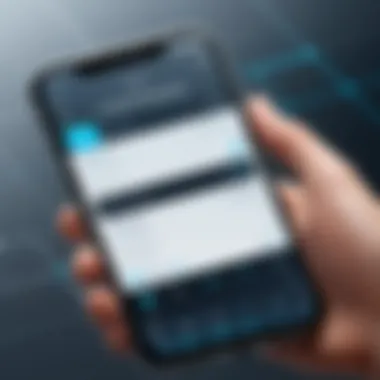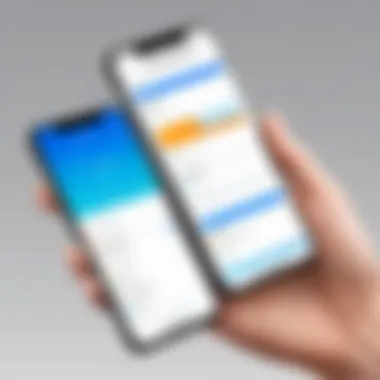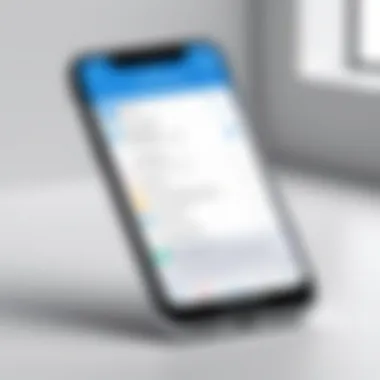Schedule Text Messages on iPhone: Top Apps Reviewed


Intro
In an age where effective communication is crucial, scheduling text messages can significantly enhance how we interact. For iPhone users, several applications offer this functionality, providing a seamless experience to send messages at the right time. This article will delve into the world of iPhone apps designed for scheduling text messages. We will look at the technology behind these apps, their design features, as well as the benefits and limitations they present.
Overview of the Technology
Key specifications
The ability to schedule text messages relies on both software and some core functionalities within the iOS ecosystem. Many apps utilize the built-in notifications that the iOS system offers. This enables users to compose messages in advance and set a specific time for them to be sent. Key specifications often include:
- User-friendly interface for easy navigation
- Ability to customize sending times
- Options for recurring messages
- Integration with contacts and calendars for streamlined use
- Option to include multimedia elements like images or video.
Unique selling points
Apps designed for scheduling text messages stand out due to several unique features. One primary advantage is flexibility; users can reach out without needing to remember to send messages at specific times. Some apps, like Scheduled or Later, also allow for integration with various platforms, sending messages through SMS or social media, which broadens their usability. Another key selling point is reminders; many apps will keep users informed about upcoming scheduled messages, reducing the risk of forgotten communications.
Design and Build Quality
Material used
While the scheduling apps themselves do not involve physical materials, the aesthetic presentation matters. User interface design is central to how intuitively users can navigate these applications, and most apps adopt a minimalistic layout that focuses on functionality. Clear fonts, enough spacing, and an organized structure are common traits among the leading apps.
Ergonomics and usability
When considering ergonomics, the best scheduling apps are designed to optimize user experience. This includes:
- Quick access to frequently used contacts
- Simplified message composition tools
- Intuitive reminder setups
- Customizable notifications that align with user preferences
By making the user journey as straightforward as possible, these apps cater to busy lifestyles, making communication scheduling an effortless task.
"Effective communication is not just about what is said, but when it is sent."
This explores the utility of scheduled messaging in personal and professional contexts.
The End
With a multitude of options available, iPhone apps for scheduling text messages can profoundly impact how users manage their communication. They provide tools that enhance efficiency and foster timely connections. Understanding the technology, design, and benefits of these applications is essential for making informed choices that suit individual communication needs. ilerating technology continues to shape how we connect, staying ahead is vital.
Prologue to Message Scheduling
In an age where instant communication has become the norm, the concept of message scheduling presents a unique solution to modern communication challenges. It is a tool designed to enhance efficiency, allowing individuals to predefine when and to whom their messages are sent. This fulfills the dual need for immediate communication and the convenience of planning ahead. The ability to schedule texts provides users the freedom to manage their time better, ensuring that important messages are not overlooked or forgotten during crucial moments.
Understanding the Need for Scheduled Messaging
Scheduled messaging addresses several modern-day needs. Often, individuals find themselves in situations where they cannot send a message at the right moment. Scheduled messaging allows for the thoughtful crafting of messages, reducing the risk of sending poorly timed texts. With the pressures of life, it's common for professionals to miss opportunities for communication when they are preoccupied or unavailable. For instance, someone might want to send a reminder for an upcoming meeting in advance while managing their workload.
Moreover, scheduled messaging can enhance personal relationships. In a time of busy schedules and varying time zones, sending a message at the right time can deepen connections. Family and friends can benefit from well-timed greetings or reminders. Overall, scheduling messages supports a balanced approach to personal and professional interactions, bringing more intentionality to communication.
Historical Perspective: Evolution of Messaging Technologies
The history of message scheduling reflects the broader evolution of communication technologies. Early communication methods relied on face-to-face conversation or written letters, both of which required direct engagement. The introduction of telecommunication revolutionized how we share information, marking a significant turn in accessibility.
As technology advanced, SMS text messaging emerged in the late 1990s, allowing users to send short messages quickly. However, the limitation of immediate communication necessitated a method to plan and schedule texts. This led to the development of applications capable of not only sending texts but also allowing users to choose when each was delivered.
Today, many messaging apps include scheduling features, highlighting the growing trend towards a more structured approach to communication. The emergence of smartphones catalyzed this shift, making it possible to incorporate integrated scheduling features within applications, ultimately changing how people interact digitally. As we analyze current tools available for iPhone users, it is evident that technological advancements have continually shaped the landscape of messaging.


Key Features of Scheduling Apps
When it comes to maximizing communication efficiency, iPhone apps for scheduling text messages must provide essential features that cater to user needs. These apps are not merely tools for sending messages at a later time; they are complex systems designed to improve user experience and functionality. Understanding these key features is critical to selecting the most appropriate app.
User Interface and Experience
The user interface (UI) is pivotal in determining how effectively users can utilize a scheduling app. A clean and intuitive layout allows users to navigate the app easily. Users should be able to find scheduling options without extensive searching. Features such as a clear calendar view can help visualize planned messages.
Moreover, user experience (UX) decisions, such as button placements and responsiveness, influence overall satisfaction. If sending or scheduling a message is cumbersome, users may abandon the app altogether. Therefore, developers must prioritize simplicity while ensuring powerful capabilities.
Notification and Reminder Functions
Built-in notification and reminder functions are crucial for scheduling apps. Users expect timely alerts before a scheduled message is sent. Effective notification systems can enhance communication by ensuring that users remember important dates or events.
Different applications might offer customizable reminders. For instance, a user may want a reminder 10 minutes before a scheduled message. Others might prefer a notification a day in advance. Flexibility in setting these reminders accommodates the diverse needs of users, making the app more practical.
Integration with Other Apps
Integration capabilities are another aspect that can greatly influence the selection of a scheduling app. A robust app should work seamlessly with other applications such as calendars, email clients, and task management tools. For instance, if a user schedules a message for a meeting, integrating with Outlook or Google Calendar could offer a streamlined experience.
This connectivity not only simplifies the workflow but also saves time. Users can avoid switching between applications to keep track of their messages and appointments. Therefore, apps that support various integrations tend to stand out in a crowded marketplace.
Effective scheduling apps must prioritize user interface, notification functions, and integration capabilities. These features enhance usability and ensure users can communicate efficiently.
Top iPhone Apps for Scheduling Text Messages
The advent of technology has significantly altered how we communicate. In the context of scheduling text messages, iPhone apps provide numerous options to enhance this efficiency. These applications allow users to send messages at predetermined times, making it easier to connect without constant attention to a phone. The benefits range from enhancing personal productivity to enabling better communication in professional contexts.
Scheduled messaging can help reduce missed opportunities and ensures that key messages are delivered promptly, catering to users’ needs even when they are not actively engaged with their devices. Furthermore, with the rise of remote work and digital communication, having the right tools at your disposal can greatly amplify your effectiveness.
App One: Overview and Key Features
Pricing and Subscription Models
When exploring pricing structures, many users often seek cost-effectiveness. App One offers a tiered subscription model that caters to varying needs. Users can access a free version with limited features, or opt for a premium subscription that unlocks advanced functionalities. This flexibility allows users to choose based on their usage patterns. The unique aspect of this pricing model is its trial period, enabling new users to assess features before committing to a purchase.
User Reviews and Ratings
User-generated reviews are crucial for evaluating the app’s performance. In this case, App One maintains a high average rating across platforms, signifying user satisfaction. Many reviewers appreciate its intuitive interface and reliability. However, some have mentioned issues with certain integrations, suggesting there is room for improvement. Overall, positive feedback enhances its appeal in the competitive market.
App Two: Overview and Key Features
Comparison with Other Apps
When comparing App Two to others in its category, several key aspects come to light. It stands out for its greater emphasis on user customization, allowing a tailored experience suited to individual preferences. Additionally, this app integrates seamlessly with various calendars and task management tools, a feature not commonly found in rival applications. Users have expressed that this integration creates a more coherent workflow, making it a popular choice among professionals.
Customization Options
Customization is a hallmark of App Two's functionality. Users can design message templates, varying the tone and style to fit different contexts. This flexibility allows for more personalized engagement, which can be especially valuable in marketing and client communications. However, while customization enhances engagement, it may also require a learning curve for first-time users. The balance between ease of use and customization remains a noteworthy consideration for potential users.
App Three: Overview and Key Features
Unique Selling Points
App Three distinguishes itself with innovative features that cater specifically to its target audience. With functionalities such as automatic follow-ups based on message responses, it anticipates user needs effectively. This responsiveness to user behavior enhances overall communication strategies, making it popular among sales professionals. Additionally, its aesthetic design appeals to those who value user experience alongside functionality.
Technical Specifications
The technical prowess of App Three supports its smooth operation across various iOS devices. It boasts low battery consumption and efficient RAM usage, ensuring devices do not get sluggish while running the app. This aspect is critical, especially for users who rely on their devices for multiple applications. While the app excels in performance, users have reported occasional bugs during updates, suggesting that ongoing support and maintenance are vital.
User Preferences and App Selection
User preferences play a significant role in the world of scheduled messaging applications. Understanding these preferences can lead to more effective app selection and usage. Different users have varying needs and expectations, which can influence how they utilize these tools. A tailored approach to app selection enhances the communication experience and improves overall satisfaction.
When selecting a scheduling app, users should consider functionalities that align with their unique lifestyles and communication habits. For instance, a professional may prioritize features that support bulk scheduling and integration with other productivity tools. In contrast, casual users may seek simple and user-friendly interfaces that require minimal setup.
By evaluating personal needs and preferences, users can choose the right app that not only meets their requirements but also enhances their messaging experience. It is also essential for users to remain adaptable, as their needs may change over time.


Analyses of user demographics can reveal patterns in preferences and behaviors, facilitating the selection process.
Analyzing User Demographics
Demographic analysis can uncover critical insights into how various groups interact with messaging applications. Understanding different age groups, professions, and lifestyles can inform developers about which features to enhance or introduce.
For example, younger users may prefer more visually engaging interfaces, while older users typically opt for straightforward designs. Additionally, business professionals might prioritize functionality over aesthetics, seeking out applications that allow efficient communication without distractions.
Moreover, geographical factors can influence messaging habits. Users in certain regions may rely on specific apps due to cultural preferences or network stability. By recognizing these trends, both users and developers can make more informed decisions regarding messaging tools.
Common Use Cases for Scheduled Messaging
Identifying common use cases for scheduled messaging assists users in selecting apps tailored to their specific situations.
- Automating Reminders: Many users rely on scheduling applications to send reminders for important events, such as meetings or birthdays. This allows recipients to receive timely notifications without additional input from the sender.
- Syncing with Work Tasks: Professionals often schedule messages to align with deadlines or project milestones. This facilitates organized communication within teams or with clients.
- Planning Social Events: Coordinating group activities can be challenging. Scheduled messages help users inform friends about meet-ups or events efficiently.
- Personalized Greetings: Users may utilize scheduling apps to send personalized messages for anniversaries or holidays, ensuring loved ones receive heartfelt wishes at the right time.
Scheduled messaging not only enhances productivity but also empowers users to communicate meaningfully without the stress of timing.
Technological Considerations for Users
In the realm of scheduling text messages, technological considerations are paramount. Users should not only focus on the visibility and usability of the app but also on how the technology behind it ensures security, performance, and longevity. Understanding these aspects can greatly influence how effectively the application serves its purpose and keeps sensitive information secure while maximizing communication efficiency.
Security and Privacy Features
Security features in scheduling apps encompass a variety of elements designed to protect user data. One critical aspect is data encryption. Encrypted messages ensure that the contents remain confidential, safeguarding against potential data breaches. Users must look for apps that utilize end-to-end encryption, which means that only the sender and receiver can access the message content.
Another important feature is the app’s privacy policy. Thoroughly reading this document can provide insight into how the app collects, uses, and shares personal data. Users should prioritize applications that have clear and stringent policies regarding data handling.
Moreover, authenticating features, such as biometric logins or two-factor authentication, add an additional layer of security. These measures help prevent unauthorized access to the app, ensuring that incoming and outgoing messages are secure. Users, therefore, should consider apps that actively implement these security measures.
Impact of iOS Updates on App Functionality
iOS updates can significantly impact the functionality of text scheduling applications. Each iOS release often includes enhancements to security, privacy, and performance that developers can leverage to improve app capabilities. However, compatibility issues may arise if the app is not updated to align with the latest iOS version. In some cases, older versions of apps may lead to a subpar user experience or even malfunction.
It is essential for users to ensure that the apps they choose remain compatible with the latest iOS updates. Notable applications frequently push updates in tune with Apple’s changes, allowing users to benefit from new features and improved security protocols.
Additionally, it is wise for users to monitor feedback from other users following an iOS update. When many report issues with a scheduling app after an update, it may indicate that the app needs further enhancement or revision to function correctly. Hence, keeping an eye on user reviews can inform better decisions regarding which apps to adopt.
"Choosing the right scheduling app means being aware of how technology evolves and how it impacts your communication tools."
Finally, always download apps from trusted sources like the App Store to mitigate risks associated with outdated or malicious software. This diligence ensures users maintain efficient and secure messaging practices.
Best Practices for Effective Use
The effective use of scheduling apps is crucial for achieving efficient communication through text messaging. Understanding best practices helps users harness technology to streamline their interactions. This section explores the elements that contribute to successful scheduling, offering insights on professional applications and personal messaging.
Scheduling Messages for Professional Contexts
In professional settings, utilizing scheduling apps can optimize communication with colleagues and clients. These tools allow for the timely dissemination of information, ensuring that important messages are sent at the most impactful moments. Here are some key considerations:
- Timing and Relevance: A well-timed message can enhance clarity and reduce the chance of misunderstandings. Remember to consider the recipient's time zone when scheduling messages.
- Content Clarity: Always ensure the message is clear and to the point. Professional messages should be concise, and well-structured. Avoid long paragraphs or overly technical jargon that might confuse the recipient.
- Follow Up: Retain the personal touch by setting reminders to follow up on critical conversations. Integrating follow-ups into your schedule can foster a more engaging communication environment.
"Effective communication is more than just sending messages; it's about ensuring messages resonate with the recipient at the right time."
Utilizing reminders and reading receipts can further enhance the communication loop, making follow-ups smoother and more effective.


Personal Messaging: Balancing Automation and Authenticity
For personal messaging, the aim often shifts toward maintaining a genuine connection while leveraging the convenience of automation. Here are some practices that can help to strike the right balance:
- Personalization: Automating text message scheduling doesn't mean removing personal touches. Customize messages with the recipient's name or refer to past conversations to maintain relevance.
- Occasional Manual Intervention: Relying solely on automation can lead to perceived insincerity. Schedule messages, but also allow space for spontaneous, heartfelt messages.
- Using Emojis Wisely: Emojis can enhance the emotional tone of messages. Use them judiciously to convey warmth but avoid overuse, which can detract from the intended message.
By employing these best practices, users can maximize the effectiveness of their scheduled texts in both professional and personal contexts. This deep understanding of scheduling tools fosters a more thoughtful approach to communication, creating stronger and more meaningful connections.
Future Trends in Messaging Applications
The landscape of messaging applications is rapidly evolving. This section delves into future trends in such applications and their implications for users, especially regarding scheduled messaging. The growth of technology and user expectations shapes these trends. Understanding these developments helps users adapt and maximize communication efficiency.
Artificial Intelligence and Messaging
Artificial intelligence is transforming messaging applications in several ways. AI chatbots are becoming increasingly common, enabling automated interactions. These systems can handle scheduling messages intelligently, suggesting optimal times based on user behavior.
Furthermore, AI enhances user experience by personalizing content. For instance, apps can learn communication patterns and recommend messages or responses based on past data.
The following benefits of AI integration in messaging apps are evident:
- Smart Scheduling: AI can analyze when your contacts are most likely to engage with your messages. This capability enhances the effectiveness of scheduled texts.
- Contextual Awareness: By understanding context, AI can suggest messages that are relevant to current events or trends.
- Efficiency: Users save time as AI handles routine tasks, allowing them to focus on more significant interactions.
This integration of artificial intelligence into messaging platforms represents a paradigm shift. It enables deeper, more meaningful conversations while streamlining communication efforts.
"The integration of AI in messaging applications leads to a future where communication is not only automated but also enhanced by data-driven insights."
The Role of Cross-Platform Compatibility
In today's diverse digital ecosystem, cross-platform compatibility has become a critical feature for messaging applications. Users interact across various devices and operating systems, making this functionality essential.
Cross-platform functionality ensures that users can schedule messages from any device, whether iPhone, Android, or web-based platforms. This capability is particularly beneficial for professionals who operate in multiple environments. Here are a few key aspects:
- Seamless Communication: Users can send scheduled texts regardless of the platform their contacts use, enhancing connectivity.
- User Convenience: Flexibility in accessing apps across devices means users can manage their messages anywhere, anytime.
- Increased Collaboration: Businesses often rely on effective team communication. Cross-platform compatibility supports this by allowing team members on different systems to remain in sync.
As we move forward, it's clear that the need for cross-platform compatibility will only increase. Users should seek apps that prioritize this feature to enhance their communication efficiency.
The future of messaging applications is bright but also complex. Keeping abreast of these trends, such as artificial intelligence advancements and cross-platform compatibility, equips users to choose the right scheduling tools for their needs.
The End: Selecting the Right Tool for Scheduling Texts
Choosing the right application for scheduling text messages is crucial for enhancing communication efficiency. Throughout this article, we discussed various aspects that influence the selection process. From understanding user needs to evaluating specific features, each element plays a significant role in determining which app will serve best for individual users.
The primary benefit of scheduling messages lies in time management. Professionals can send reminders or updates at designated times, reducing the likelihood of missed communications. This feature is especially valuable in today’s fast-paced environment where timely information is critical. Moreover, these apps offer customizable options, allowing users to tailor their messaging approach to fit both personal and professional needs.
Considerations regarding security and privacy cannot be overlooked. Users must ensure that the app they choose adheres to strong security protocols. This is essential in guarding against potential breaches or unauthorized access to sensitive information.
Overall, it’s important to balance functionality and usability. The ideal app should not only meet scheduling needs but also provide a user-friendly interface that encourages frequent use.
"The selection process for a messaging app requires careful consideration of user needs, app features, and security."
Recap of Key Insights
In summary, several key insights emerge from our examination of iPhone apps for scheduling text messages:
- Functionality: Effective scheduling features are vital. Look for apps that allow users to send texts at precise times.
- User Experience: A clean and intuitive interface enhances ease of use, making scheduling messages more accessible.
- Integration: Applications that integrate well with other platforms offer added convenience.
- Security: Prioritize apps that safeguard personal data, ensuring privacy is maintained.
- User Feedback: Ratings and reviews serve as valuable indicators of an app’s reliability and performance.
These insights point to essential elements that should guide your choice of messaging application. Identifying your specific needs can significantly improve the effectiveness of your communications.
Encouragement to Explore Available Options
With the wealth of options available, users are encouraged to explore different applications for scheduling text messages. Each app possesses unique features, catering to varying user preferences. Users should take the time to experiment with several applications, which will provide firsthand experience about their functionality.
Consider starting with some highly-rated apps mentioned in earlier sections, as they have proven effective for many users. Trial versions or free offerings can serve as a risk-free way to assess whether an app meets your requirements.







